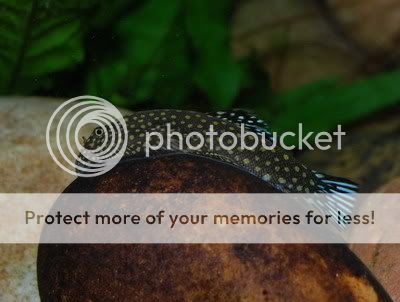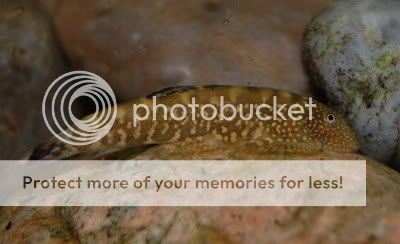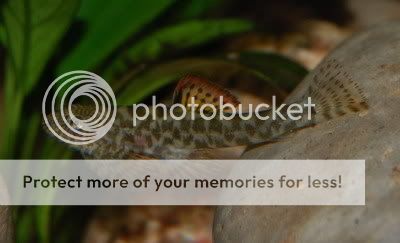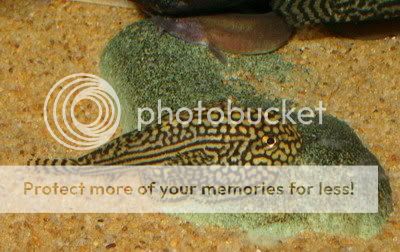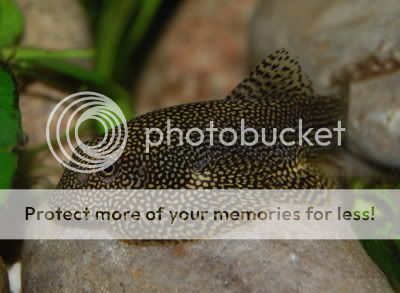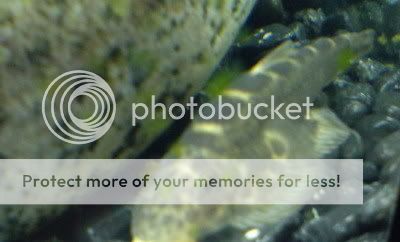-germ-
Rheophilic....
Common Name(s): Butterfly Hillstream Loach, Chinese Hillstream Loach, China/Hong Kong Pleco, Chinese Sucker, Lizard Loach, Stingray Pleco/Loach, Borneo Sucker
Scientific Name: Beaufortia kweichowensis
Family: Balitoridae
Origin: China
Maximum Size: 4"
Life Span: 6 years
Care: 'Butterfly Hillstream Loaches' are rheophilic fish, in nature they inhabit fast flowing, cool and very highly oxygenated water in which they use their modified ventral fins to cling onto rocks in the current. In order to keep this fish suitably you should provide strong water movement at all levels of the tank. Particular care must be taken to ensure strong surface movement so as to provide a sufficient oxygen supply.
Temperature should be between 20 and 24 degrees celcius.
Smooth rocks should be present as grazing and resting space, they commonly spend most of their time on the tank glass and aforementioned rocks. They rarely venture onto the substrate, generally only for food. Hiding places should also be provided, again with smooth surfaces to rest on.
A strong and mature algae build up should be present before addng these fish, they will graze on this for the tiny organisms that inhabit it (example; tiny crustaceans, protozoans).
This goes hand in hand with providing strong lighting to encourage algae growth, especially light from the blue part of the spectrum.
Feeding: Aside from algae and its inhabitants the 'Butterfly Hillstream Loach' can be a fussy eater. They have been known to take; flaked food, algae wafers, sinking catfish pellets, blanched veg such as kale, spinach and courgette, bloodworm and brine shrimp.
I have personally found most success with algae wafers and courgette.
Sexing and Breeding: Unknown on both counts.
Notes: Many fish are sold under the common names provided above, Beaufortia Kweichowensis being particularly common, however it is recommended that you identify your individual fish species. Although most have similar requirements some species of 'Butterfly Hillstream Loach' can been bred in aquarium, other species may also have subtle differences in environmental and dietary preference.
Please see post #2 for elaboration on other Balitoridae species.
Colour changes do take place in these 'Loaches', this behaviour is most common at night when the colourloss is seen as a natural form of energy saving, dark, camoflauged colouration not being as necessary due to the lack of nocturnal predators in their natural environment. Colourloss can also take place during territorial disputes.
Territorial disputes rarely lead to injury and are a natural behaviour, commonly involving nose-poking the opponent, flashing of the dorsal fin, side swiping the opponent and occasionally sitting on top of the opponent.
1
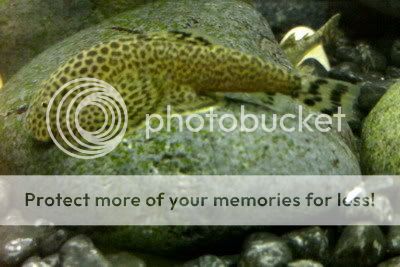 Beaufortia Kweichowensis
Beaufortia Kweichowensis
2
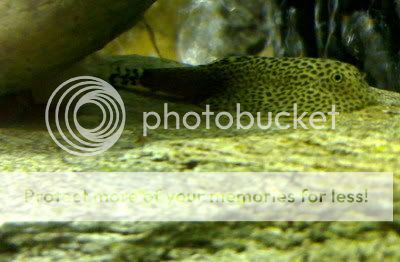 Beaufortia Kweichowensis
Beaufortia Kweichowensis
Scientific Name: Beaufortia kweichowensis
Family: Balitoridae
Origin: China
Maximum Size: 4"
Life Span: 6 years
Care: 'Butterfly Hillstream Loaches' are rheophilic fish, in nature they inhabit fast flowing, cool and very highly oxygenated water in which they use their modified ventral fins to cling onto rocks in the current. In order to keep this fish suitably you should provide strong water movement at all levels of the tank. Particular care must be taken to ensure strong surface movement so as to provide a sufficient oxygen supply.
Temperature should be between 20 and 24 degrees celcius.
Smooth rocks should be present as grazing and resting space, they commonly spend most of their time on the tank glass and aforementioned rocks. They rarely venture onto the substrate, generally only for food. Hiding places should also be provided, again with smooth surfaces to rest on.
A strong and mature algae build up should be present before addng these fish, they will graze on this for the tiny organisms that inhabit it (example; tiny crustaceans, protozoans).
This goes hand in hand with providing strong lighting to encourage algae growth, especially light from the blue part of the spectrum.
Feeding: Aside from algae and its inhabitants the 'Butterfly Hillstream Loach' can be a fussy eater. They have been known to take; flaked food, algae wafers, sinking catfish pellets, blanched veg such as kale, spinach and courgette, bloodworm and brine shrimp.
I have personally found most success with algae wafers and courgette.
Sexing and Breeding: Unknown on both counts.
Notes: Many fish are sold under the common names provided above, Beaufortia Kweichowensis being particularly common, however it is recommended that you identify your individual fish species. Although most have similar requirements some species of 'Butterfly Hillstream Loach' can been bred in aquarium, other species may also have subtle differences in environmental and dietary preference.
Please see post #2 for elaboration on other Balitoridae species.
Colour changes do take place in these 'Loaches', this behaviour is most common at night when the colourloss is seen as a natural form of energy saving, dark, camoflauged colouration not being as necessary due to the lack of nocturnal predators in their natural environment. Colourloss can also take place during territorial disputes.
Territorial disputes rarely lead to injury and are a natural behaviour, commonly involving nose-poking the opponent, flashing of the dorsal fin, side swiping the opponent and occasionally sitting on top of the opponent.
1

2



